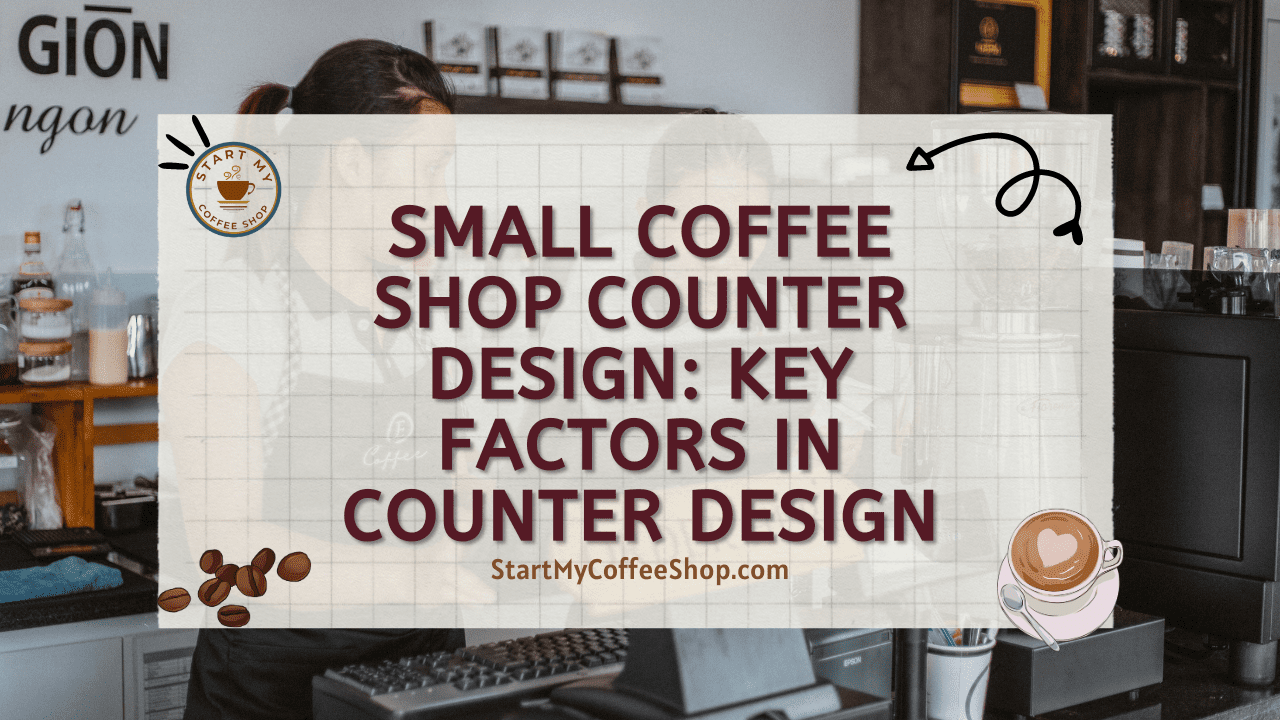When it comes to designing a small coffee shop counter, attention to detail and careful planning are crucial. The counter serves as the heart of your coffee shop, where baristas work their magic and customers interact with your brand.
When designing a small coffee shop counter, consider factors like efficient space utilization, ergonomic layout, easy access to equipment, sufficient storage, attractive display options, and a welcoming customer interaction zone.
In this article, I will explore the key considerations that can make a significant difference in creating an efficient, attractive, and customer-friendly coffee shop counter.
1. Efficient Space Utilization
 In a small coffee shop, where space is at a premium, every inch matters. Maximizing space utilization becomes crucial to create a smooth workflow and ensure efficient operations. When designing the layout of your coffee shop counter, careful consideration should be given to strategically placing equipment to minimize clutter and promote easy access for baristas.
In a small coffee shop, where space is at a premium, every inch matters. Maximizing space utilization becomes crucial to create a smooth workflow and ensure efficient operations. When designing the layout of your coffee shop counter, careful consideration should be given to strategically placing equipment to minimize clutter and promote easy access for baristas.
One of the key aspects to focus on is the arrangement of essential equipment such as espresso machines, grinders, and blenders. These pieces of equipment are the lifeblood of your coffee shop, and their placement can greatly impact the efficiency of your operations. By positioning them strategically, you can create a well-designed workflow pattern that optimizes baristas’ movements and enables them to serve customers swiftly.
When arranging the equipment, think about the logical sequence of tasks. For example, place the espresso machine near the coffee grinder to streamline the process of grinding and brewing coffee. Consider the flow of ingredients and tools, ensuring that everything is within reach and easily accessible for the baristas. This can minimize the time spent searching for items, allowing them to focus on delivering high-quality drinks to customers.
Additionally, organizing the counter space efficiently involves optimizing the storage areas. Use shelving, cabinets, or drawers to store supplies, cups, and utensils. Designate specific areas for different categories of items to maintain order and prevent unnecessary clutter. Keeping the counter tidy and well-organized not only enhances the aesthetic appeal but also contributes to a smoother workflow.
Another consideration is the arrangement of customer service areas. Designate a separate space for taking orders and interacting with customers. This can be achieved by creating a clearly defined customer interaction zone within the counter design. By incorporating a designated area where customers can place their orders and ask questions, you provide a seamless and personalized experience. This not only improves customer satisfaction but also allows baristas to focus on their tasks without interruptions.
2. Ergonomic Layout
 Creating an ergonomic layout for your coffee shop counter is not just about aesthetics; it directly impacts the comfort and productivity of your baristas. When designing the counter, careful consideration should be given to the height and placement to ensure that it allows for easy reach and minimizes strain on the baristas’ bodies.
Creating an ergonomic layout for your coffee shop counter is not just about aesthetics; it directly impacts the comfort and productivity of your baristas. When designing the counter, careful consideration should be given to the height and placement to ensure that it allows for easy reach and minimizes strain on the baristas’ bodies.
First and foremost, the height of the counter should be suitable for the average height of your baristas. It should be neither too low nor too high, as this can lead to discomfort and potential health issues over time. Ensuring that the counter height aligns with the baristas’ natural arm position when performing tasks like preparing drinks or handling transactions is essential. This alignment helps in reducing strain on their backs, shoulders, and arms, enabling them to work comfortably for extended periods.
Moreover, the placement of equipment and supplies should also be considered in terms of ergonomics. Baristas should not have to overreach or bend in awkward positions to access commonly used items. For instance, frequently used tools, such as coffee grinders or milk frothers, should be placed within arm’s reach to avoid unnecessary stretching or twisting movements. This promotes efficiency and minimizes the risk of strains or repetitive motion injuries.
By prioritizing ergonomics in the counter design, you can contribute to a positive working environment. Comfortable baristas are more likely to be focused and productive, providing excellent customer service. Additionally, an ergonomic counter layout demonstrates your commitment to the well-being of your staff, fostering a positive company culture and employee satisfaction.
It is worth noting that ergonomics is not a one-size-fits-all concept. Each barista may have different preferences and physical requirements. It can be beneficial to involve your staff in the design process by seeking their input and feedback. Their insights can provide valuable information on what adjustments and modifications may be necessary to optimize comfort and productivity.
3. Easy Access to Equipment
 Efficiency and speed are the lifeblood of a coffee shop, and the design of your counter plays a crucial role in achieving these goals. When creating the counter layout, it is vital to prioritize easy access to essential equipment and supplies to facilitate a seamless workflow for your baristas.
Efficiency and speed are the lifeblood of a coffee shop, and the design of your counter plays a crucial role in achieving these goals. When creating the counter layout, it is vital to prioritize easy access to essential equipment and supplies to facilitate a seamless workflow for your baristas.
A well-designed counter should ensure that baristas can reach for coffee beans, milk, cups, utensils, and other necessary items without any hindrance. Logically organize the counter space, placing these items near the baristas’ workstations. For example, position the coffee beans near the grinder and the milk next to the espresso machine. This allows baristas to efficiently access the ingredients they need for each drink preparation, minimizing unnecessary movement and saving precious time.
In addition to ingredient accessibility, the placement of utensils and tools should be considered. Ensure that spoons, stirring sticks, straws, and other utensils are readily available near the appropriate stations. This eliminates the need for baristas to search for these items, ensuring a smooth workflow and preventing delays in serving customers.
An organized and easily accessible counter also contributes to maintaining a consistent and high level of customer service. When baristas can swiftly access the necessary supplies, they can focus on delivering quality drinks and engaging with customers. It enables them to handle multiple orders efficiently, reducing wait times and enhancing overall customer satisfaction.
Streamlining the workflow through efficient counter design is not only beneficial for the baristas but also for the customers. A smooth and expedited service enhances the overall experience and encourages customers to return to your coffee shop.
Regularly evaluate the layout and functionality of your counter to identify any potential bottlenecks or areas for improvement. Seek feedback from your baristas, as they are at the forefront of the operations and can provide valuable insights on how to optimize the counter design further.
Read more about Small Coffee Shop Startup Cost: A Holistic Look at the Costs of Opening a Coffee Shop
4. Sufficient Storage Solutions
Effective storage solutions play a pivotal role in ensuring a clutter-free and organized coffee shop counter. With limited space, it becomes even more crucial to optimize storage options and keep essential supplies readily accessible. Depending on the available space, incorporating cabinets, shelves, or drawers can provide efficient storage for items such as coffee beans, syrups, and cleaning materials.
Cabinets offer a concealed storage option, keeping supplies neatly tucked away while maintaining a clean and visually appealing counter. Choose cabinets with multiple shelves to maximize vertical space utilization. Ensure that these cabinets are strategically placed within reach of the baristas, avoiding the need for excessive bending or stretching. Proper organization within the cabinets, such as utilizing labeled bins or containers, can further enhance accessibility and minimize the time spent searching for specific items.
Open shelves are another excellent storage solution for frequently used items or those with an aesthetic appeal. Consider placing attractive glass jars filled with coffee beans or labeled bottles of syrups on these shelves. Not only does this create an appealing visual display, but it also allows for easy access and quick replenishment.
Drawers are particularly useful for storing smaller supplies like utensils, straws, and napkins. Incorporating dividers within the drawers helps to keep items organized and prevents them from becoming jumbled or difficult to find. Consider dedicating specific drawers for different types of supplies to further streamline the retrieval process.
When designing your counter, it’s essential to strike a balance between accessibility and aesthetics. While the storage areas need to be within reach for the baristas, it’s equally important to keep them discreetly hidden from the customers’ view. This ensures a clean and uncluttered counter, enhancing the overall experience for both the baristas and customers.
Regular maintenance and inventory management are crucial for effective storage solutions. Implement a system to regularly check and restock supplies, ensuring that everything is in its designated place. This reduces the risk of shortages during busy periods and helps maintain an organized counter throughout the day.
Additionally, consider conducting periodic assessments of your storage needs as your coffee shop grows and evolves. Analyze the efficiency of your current storage solutions and make adjustments as necessary. As your menu expands or changes, you may need to reevaluate the storage requirements and make modifications to accommodate new ingredients or equipment.
5. Attractive Display Options
The counter of your coffee shop serves as more than just a functional workspace; it is an opportunity to captivate customers and enhance their overall experience. Creating an attractive display on your counter can entice customers, spark their curiosity, and even lead to impulse purchases. Consider incorporating elements such as glass display cases or open shelving to showcase your delectable pastries, mouth-watering desserts, or enticing merchandise.
Glass display cases offer a visually appealing and hygienic way to showcase your edible delights. Place freshly baked pastries, colorful macarons, or delectable cakes inside these cases, allowing customers to feast their eyes on the tantalizing treats. The transparent glass not only protects the products but also invites customers to visually engage with the offerings, enticing them to indulge their sweet cravings.
Open shelving can be a versatile option to display items that don’t require refrigeration. Arrange beautifully packaged coffee beans, specialty teas, or artisanal chocolates on these shelves. Consider incorporating different heights and angles to create visual interest and make the display more engaging. By showcasing your merchandise in an aesthetically pleasing way, you create a sense of desire and make it more likely for customers to make impulse purchases.
In addition to the physical displays, leverage eye-catching signage and branding elements to highlight special drinks or promotions. Utilize colorful chalkboards, acrylic signs, or digital displays to draw attention to signature beverages, seasonal specials, or limited-time offers. Clever and well-placed signage can pique customers’ curiosity and guide their choices, leading to increased sales and customer satisfaction.
Remember to incorporate branding elements throughout the counter display. Utilize your coffee shop’s logo, colors, and fonts to maintain consistency and reinforce your brand identity. This creates a cohesive visual experience for customers, leaving a lasting impression of your unique coffee shop.
A visually appealing counter goes beyond aesthetics; it serves as a powerful marketing tool. It captures customers’ attention and entices them to explore your offerings further. When customers are visually engaged and tempted by the display, they are more likely to indulge in impulse purchases or try new items, contributing to increased revenue and customer satisfaction.
Regularly update your counter display to keep it fresh and exciting. Rotate seasonal items, introduce new products, or highlight customer favorites to keep customers coming back for more. Continuously evaluate the effectiveness of your display by monitoring sales trends and gathering feedback from customers and staff.
6. Welcoming Customer Interaction Zone
The coffee shop counter serves as more than just a functional work area—it also acts as a space for customers to engage with your brand and create a memorable experience. Designing a welcoming customer interaction zone within the counter layout is essential to foster a sense of inclusivity and connection.
To create this interaction zone, consider incorporating a designated space where customers can place their orders, ask questions, and interact with the baristas. This area should be well-defined, clearly marked, and easily identifiable to customers. Utilize signage or floor markings to guide customers towards this designated zone, ensuring they feel confident in where to go and how to engage with your staff.
Seamless integration is key when designing the customer interaction zone. It should harmoniously blend into the overall counter design without creating barriers or disrupting the workflow. Whether it’s a slightly lowered section of the counter, a strategically placed stand, or a separate station nearby, the interaction zone should be within the baristas’ reach and visibility to facilitate smooth communication.
Consider the placement of additional elements that can enhance customer engagement. For example, strategically position menu boards, promotional displays, or branded merchandise in the customer interaction zone to capture their attention and encourage further interaction. By creating a visually appealing environment, you can stimulate curiosity and encourage customers to explore your offerings.
A well-designed interaction zone not only promotes a sense of inclusivity but also allows for personalized customer service. It provides an opportunity for baristas to establish rapport, engage in conversation, and create a positive customer experience. By actively listening to customers’ preferences, answering questions, and offering recommendations, baristas can build connections and loyalty, leaving a lasting impression.
Regularly assess the customer interaction zone to ensure its effectiveness. Seek feedback from customers and baristas to identify any areas for improvement. Consider adjusting the design elements, signage, or layout based on their input to create an even more welcoming and engaging space.
Read more about Running Costs of a Coffee Shop: Mastering the Art of Cost Management
7. Technology Integration
Embracing technology in your coffee shop counter design can bring about significant improvements in efficiency and customer satisfaction. By integrating various technological advancements such as POS systems, digital menu boards, and self-service kiosks, you can streamline the ordering process, minimize wait times, and offer customers a modern and convenient experience.
One of the key technological integrations to consider is a POS (Point of Sale) system. These systems centralize the ordering, payment, and inventory management processes, replacing traditional cash registers. With a POS system, baristas can efficiently process orders, track inventory, and generate reports for better business insights. This not only saves time but also reduces the risk of errors, enhances accuracy, and enables seamless transactions.
Digital menu boards are another valuable addition to your coffee shop counter. These vibrant and interactive displays replace traditional static menu boards and offer several advantages.
Digital menu boards allow for easy updates and customization, enabling you to showcase daily specials, promotions, or seasonal offerings with just a few clicks. The dynamic nature of these boards attracts attention and provides customers with a visually appealing and engaging way to explore your menu options.
Self-service kiosks are becoming increasingly popular in the coffee shop industry. These interactive terminals allow customers to place their orders and make payments themselves, reducing the need for extensive staff involvement.
Self-service kiosks streamline the ordering process, minimize wait times, and offer customers more control over customizing their drinks. They can also integrate with loyalty programs, making it easier to track customer preferences and provide personalized recommendations.
By embracing technology, you not only improve operational efficiency but also enhance the overall customer experience. Shorter wait times, accurate orders, and the convenience of self-service options can significantly impact customer satisfaction and loyalty. Additionally, incorporating technology into your coffee shop counter design positions your business as modern and forward-thinking, appealing to tech-savvy customers and attracting new clientele.
When integrating technology, it’s essential to consider the specific needs of your coffee shop and the preferences of your target audience. Ensure that the chosen technologies align with your business goals, budget, and operational capabilities. Additionally, provide adequate training to your staff to ensure they are well-versed in operating the technology and can assist customers when needed.
8. Lighting and Ambiance
Lighting is a key element in setting the desired ambiance within your coffee shop. By incorporating both functional and decorative lighting elements, you can create a welcoming and visually appealing environment for both customers and baristas. Proper lighting enhances the overall atmosphere and can significantly impact the mood and experience of those visiting your coffee shop.
When designing the lighting for your coffee shop counter, it is important to strike a balance between functionality and aesthetics. Functional lighting ensures optimal visibility for baristas while they work, ensuring that they can perform their tasks with precision and efficiency. Brighter task lighting in the work areas such as the espresso machine station and preparation areas is essential to ensure accuracy in measuring ingredients and maintaining consistent quality in drink preparation.
On the other hand, decorative lighting plays a crucial role in creating the desired ambiance and setting the mood within your coffee shop. Warm, soft lighting can create a cozy and inviting atmosphere, making customers feel comfortable and relaxed while enjoying their beverages. Consider using warm-toned bulbs or fixtures to achieve this effect. Dimmer switches can also be installed to adjust the lighting intensity as needed, allowing you to create different moods throughout the day or for specific events.
In addition to lighting intensity, consider the color scheme and design elements of your coffee shop. Lighting can accentuate and enhance the visual appeal of your space. For instance, using accent lighting to highlight decorative elements, artwork, or signage can create focal points and draw attention to specific areas of interest. It is also important to ensure that the lighting fixtures complement the overall aesthetic and design theme of your coffee shop, whether it be modern, rustic, or minimalist.
As you design the lighting layout, consider the overall layout and flow of your coffee shop counter. Adequate lighting should be provided in customer interaction zones, allowing customers to see the menu, read signage, and comfortably engage with the baristas. Creating a well-lit and visually pleasing environment not only improves the overall experience for customers but also provides a positive working environment for your baristas.
Summary
Designing a small coffee shop counter requires careful consideration of various factors. From efficient space utilization and ergonomic layout to storage solutions and visual appeal, each element contributes to the overall performance of your coffee shop. By incorporating these key considerations and infusing your unique brand identity, you can create a counter that not only delights customers but also supports the seamless operations of your coffee business. So, grab your sketchbook and start designing a coffee counter that will become the talk of the town!
Frequently Asked Questions
1. How should I determine the ideal size for my small coffee shop counter?
Determining the size of your coffee shop counter depends on various factors such as available space, anticipated customer traffic, and the equipment you plan to use.
2. What are some must-have equipment for a small coffee shop counter?
Essential equipment for a small coffee shop counter typically includes an espresso machine, coffee grinder, blender, refrigeration unit, and a cash register or POS system.
3. How can I optimize the layout of my small coffee shop counter?
To optimize your counter layout, prioritize easy access to equipment and supplies, create designated stations for different tasks, and ensure a smooth flow of movement for baristas.
To learn more on how to start your own coffee shop checkout my startup documents here
Please note: This blog post is for educational purposes only and does not constitute legal advice. Please consult a legal expert to address your specific needs.

Hi! I’m Shawn Chun
My adventure in coffee began when I first launched my first coffee shop back in the early 2000s. I had to figure out so many things on my own and to make it worse within 2 years of opening two large corporate coffee chains moved in just blocks away from me!
As I saw smaller and even some larger coffee shops in the neighborhood slowly lose customers to these giant coffee chains and slowly close up shop, I knew that I had to start getting creative…or go out of business.
I (like you may be) knew the coffee industry well. I could make the best latte art around and the foam on my caps was the fluffiest you have ever seen. I even had the best state-of-the-art 2 group digital Nuova Simonelli machine money could buy. But I knew that these things alone would not be enough to lure customers away from the name brand established coffee shops.
Eventually, through lots of trial and error as well as perseverance and creativity I did find a way to not only survive but also thrive in the coffee/espresso industry even while those corporate coffee chains stayed put. During those years I learned to adapt and always faced new challenges. It was not always easy, however, in the end, I was the sole survivor independent coffee shop within a 10-mile radius of my location. Just two corporate coffee chains and I were left after that year. All told the corporate coffee chains took down over 15 small independent coffee shops and kiosks and I was the last one standing and thriving.
Along the years I meet others with the same passion for coffee and I quickly learned that it is not only “how good a barista is” that makes a coffee shop successful, but the business side of coffee as well.
Hence why I started this website you are on now. To provide the tools and resources for up and coming coffee shop owners to gain that vital insight and knowledge on how to start a coffee shop successfully.
Stick around, browse through my helpful blog and resources and enjoy your stay! With lots of LATTE LOVE!
Shawn






